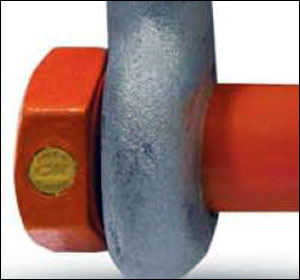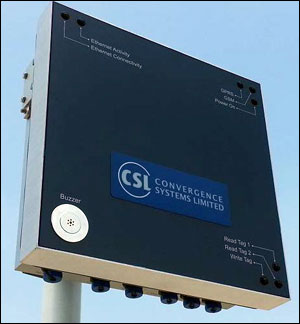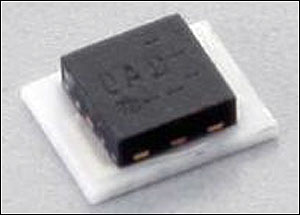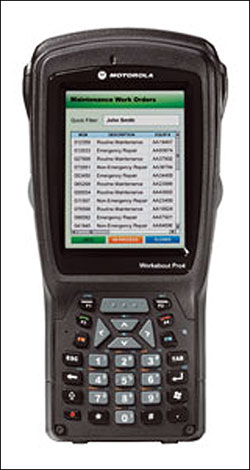The following are news announcements made during the past week by the following organizations:
Columbus McKinnon, InfoChip;
Convergence Systems Ltd.;
TeleTracking, Hill-Rom;
Murata;
Motorola Solutions;
InvoTech;
Censis Technologies, Xerafy; and
IDTechEx.
Columbus McKinnon Embeds InfoChip RFID Tags in Shackles, Hoists
Columbus McKinnon (CM) a designer, manufacturer and marketer of material-handling products, has introduced its CM Smart ID RFID technology on hoists and rigging products. When integrated with a complete inventory- and inspection-management system, CM Smart ID can enable faster inventory tracking and serialization, more efficient safety inspections and improved inventory and inspection data accuracy, CM reports. The RFID option has been developed through a partnership with InfoChip. According to CM, the integrated RFID technology means that before the product leaves the factory, each chip is associated with detailed product information that is uploaded and stored on the CM Smart ID Cloud. This allows for easy access to the information by anyone, anywhere, at any time, the company explains. All that a user needs is a free InfoChip mobile application running on a Near Field Communication (NFC)-equipped smartphone, tablet or handheld reader. The product and service information can be added to or updated after the product leaves the factory. CM Smart ID is available standard on all CM Bandit ratchet lever hoists for the U.S. market, and will also be offered as an option on select CM shackles as small as 1/2 inch. CM is using InfoChip’s DuraDisc on the CM Bandit hoists. Initially, the firm is utilizing InfoChip’s 8-millimeter (0.3-inch) DuraPlug on the shackles, with plans to transition to InfoChip’s 6-millimeter (0.2-inch) DuraPlug sometime next month. CM intends to add CM Smart ID technology on other hoists and rigging tools in the near future as well. Currently, the company is not offering RFID readers to customers, and will be directing them to InfoChip if they wish to purchase one.
Convergence Systems Ltd. Fixed Reader Includes 3G, GPS
Convergence Systems Limited (CSL), a global provider of passive RFID products and active real-time location system (RTLS) equipment, has announced the availability of its CS208-3G fixed RFID reader with 3G connectivity and GPS technology. It is particularly suited to stationary check-in/checkout asset-management solutions, the company reports, as well as large area continuous scanning solutions in access control, event management and inventory management. According to the company, applications include highway toll stations, bus stops, container ports, warehouse docks, parking lots and more. It supports the EPC Class 1 Gen 2 ultrahigh-frequency (UHF) RFID protocol, and is available with support for Dense Reader Mode. The fixed reader is ruggedized, with an IP 68 rating (meaning it is dustproof and waterproof). It measures 300 millimeters (11.82 inches) in length and width, and 100 millimeters (3.94 inches) thick, and weighs 3.5 kilograms (7.7 pounds). With its integrated high-powered, circular polarization antenna (with a choice of left- or right-hand polarization), the CS208-3G can provide a read range of up to 13 meters (42.7 feet) with DogBone tags (the FCC version) from Smartrac and features a wide selection of connectivity options: 3G/GSM/GPRS, SMS, Ethernet, USB and serial. The CS208-3G reader can be deployed outdoors or indoors for mobile or stationary applications, CSL reports, using either remote or local networks. Thanks to its built-in GPS, the reader’s location can be identified when used outdoors. It employs the Win CE operating system and has application programming interfaces (APIs) ranging from high-level HTTP to C# to low-level C. The CS208-3G is being used in conjunction with the company’s CS9010 battery-assisted passive (BAP) RFID ID card for a high-security child-tracking solution. The BAP ID card, according to CSL, which can be read consistently and reliably when hanging from a person’s neck or embedded in a wallet, backpack or purse, is tracked via the CS208-3G fixed reader, which then sends a wireless confirmation message to mobile devices to provide peace of mind for parents and school officials. The CS208-3G will be demonstrated at the RFID Journal LIVE! conference and exhibition, being held in Orlando, Fla., on Apr. 8-10, at CSL’s booth (738).
TeleTracking, Hill-Rom Integrate RTLS, Hand-Hygiene Monitoring
TeleTracking Technologies has announced a partnership with Hill-Rom Co., a hospital and medical products provider, and GOJO Industries, which manufactures’ Purell hand sanitizer. According to TeleTracking, he partnership is designed to help hospitals use the company’s real-time locating system (RTLS) to track, measure and report hand hygiene compliance, a critical tool in the fight against hospital-acquired infections, which claim up to 100,000 lives and cost hospitals an estimated $45 billion annually. The integrated solution includes Hill-Rom’s RTLS-enabled Hand Hygiene Compliance Solution software, GOJO’s Smartlink technology for hands-free dispensing and TeleTracking’s AssetTracking RTLS system, which relies on infrared-based location positioning and a 900 MHz communication backbone. The TeleTracking RTLS solution will monitor and record each time that a staff member uses, or does not use, a hand-hygiene station, the company explains. The RTLS-linked compliance system works by first alerting caregivers with a gentle reminder as they enter a care environment. When a worker uses the hands-free dispenser, an internal wireless transmitter lights up an external window confirming use, and data about that use is recorded. That information provides hospitals with the information they need to measure staff compliance and establish accountability, according to TeleTracking. The system can also benefit hospitals faced with reimbursement penalties and possible lawsuits due to infection, the company adds.
Murata Announces Availability of RFID Tag Module With I2C Interface
Murata Manufacturing Co. has announced the availability of its LXMS2HACNF-165 RFID tag module that features an NXP Semiconductors Ucode I2C RFID chip that supports a wired I2C interface. Conforming to the ISO/IEC 18000-6C and EPCglobal Class Gen 2 standards, and operating in the 900 MHz frequency band, the device is the latest addition to the surface-mount Magicstrap family of RFID chips. Magicstrap RFID tag modules employ a printed circuit board’s ground plane as a tag antenna (see Electronics Factory Uses RFID to Manage Assembly of Cisco Circuit Boards). According to Murata, the addition of an I2C interface to the ultrahigh-frequency (UHF) RFID tag module means that the data of an IC mounted on a customer’s equipment, and connected to it, can be interrogated using an UHF RFID reader, and can be read by an IC. This extends the possible applications far beyond the use of previous Magicstrap RFID chips, the company reports, which have been in the areas of process management, commodity management or traceability. Potential applications for this new RFID device include the management of memory settings of consumer appliances prior to shipping. For example, the settings of equipment can be changed even when it is packaged in a carton box immediately prior to shipment. Other examples include holding appliance error log data or recording environmental data, such as temperature changes in food service supply chain logistics applications. Using an I2C Magicstrap module makes it possible to achieve lower power consumption compared to other RF technologies, Murata claims, since the power necessary for communication is supplied by an RFID reader. Access to the RFID module is even possible when the power of the device equipped with the Magicstrap is turned off. In addition, with the I2C connection, a wireless interface can be implemented at a lower cost than Bluetooth, Wi-Fi and ZigBee, as use of UHF RFID does not require certification on the tag side, according to the company.
Motorola Solutions Intros New Workabout Pro 4 Mobile Computer with RFID Options
Motorola Solutions has introduced its Workabout Pro 4 rugged mobile computer, a modular device that businesses can customize to meet their mobile workers’ specific needs. The ergonomic Workabout Pro 4 now supports modules capable of reading low-frequency (LF), high-frequency (HF) and ultrahigh-frequency (UHF) RFID tags (linear and circular variants), Motorola Solutions reports. The new LF module now offers support for the Temic LF tag protocol; the HF module has two secure access module (SAM) sockets available for data encryption and secured transactions, while the UHF module has 1 Watt RF power for the United States and Canada (previously, it was limited to 0.5 Watt). The Workabout Pro 4 offers the following multi-modal options that were not available in earlier Workabout generations: the combination of RFID and camera (LF, HF and UHF linear); the combination of RFID and GPS; and the combination of RFID and UMTS/HSPA (GPRS only on Workabout Pro 3). The Workabout Pro 4 is designed for manufacturing, transportation and logistics, warehousing, field service and government environments, for applications such as voice picking, proof of delivery, vehicle maintenance and remote expert solutions. It is built on an entirely new platform that includes a faster 1 GHz Sitara AM37x processor, a larger memory footprint with 512 MB RAM and 4 GB flash memory, and 802.11n support. New modules include an 8-megapixel camera, new Motorola Scan Engines (1D standard range laser, 1D extended range laser, 1D linear imager and 2D imager), and a GPS/Wi-Fi antenna (along with the RFID modules). With the high-resolution 8-megapixel camera, Motorola Solutions reports, a user can take advantage of new applications, such as capturing indisputable proof of delivery and documenting damaged packages. The device uses Microsoft‘s Windows Embedded CE 6.0 and Windows Embedded Handheld 6.5 operating systems, as well as Bluetooth communications and optional wireless wide-area network (WAN) communications.
Palace Resorts Implements InvoTech’s RFID-Enabled Laundry System
Palace Resorts has recently installed InvoTech Systems‘ Multi-Property RFID Linen and Laundry Systems to automate control of its linen inventories and establish more efficient laundry operations at all seven of its oceanfront resort properties, as well as at its laundry distribution center. Palace Resorts has approximately 500,000 linens tagged with EPC Gen 2 passive ultrahigh-frequency (UHF) RFID laundry tags made by Fujitsu Frontech North America. The solution includes Impinj UHF RFID Speedway Revolution readers for all fixed reading stations, and MC9190-Z handheld readers from Motorola Solutions, utilizing InvoTech Mobile Software. InvoTech installed UHF-RFID Linen Reading Stations at each Palace Resort for the real-time tracking and processing of entire laundry carts of soiled linens going to Palace Resorts’ laundry distribution center, InvoTech reports. The UHF-RFID Linen Reading Stations also process pallets of bundled clean linens returned by the laundry. The pallets carry as many as 3,000 linen items, according to the company. InvoTech has provided Palace Resorts with both Spanish- and English-language operating systems, so each user can specify his or her preferred language for ease of use. InvoTech also supplied onsite system training and reference guides in both Spanish and English. Palace Resorts’ corporate operations director, Lorena Zahoul, has said that the systems will help consolidate all laundry processing, centralize inventory and increase staff productivity. The resort also utilizes InvoTech’s Multi-Property Uniform System to track and manage employee uniforms. The system maintains employee uniform assignments, establishes accountability and reduces loss, InvoTech reports, while also enabling Palace Resorts to transfer uniforms between properties—which, the firm reports, has significantly reduced uniform purchases since the system’s installation in 2008.
Xerafy, Censis Technologies Partner on RFID for Sterilization of Surgical Instruments
RFID tag supplier Xerafy is teaming up with Censis Technologies, a provider of surgical instrument tracking solutions. The two companies are working on a solution that leverages Xerafy’s on-metal RFID tags and Censis’ Censitrac portfolio to provide an accurate, time-saving alternative to bar codes and other methods used for tracking surgical instruments and trays as they are moved between sterile processing departments (SPDs), operating rooms and other areas. Censitrac has multiple software modules that give hospitals the ability to track the locations of surgical instruments, trays and other assets in real time, produce usage history and asset utilization reports, ensure proper sterilization procedures are followed, maintain reprocessing records and provide other information to optimize OR management and improve patient safety. Censitrac users typically apply Data Matrix two-dimensional (2D) bar codes to the items they want to track and manage, but RFID tags provide an alternative identification method. The development effort will leverage Xerafy’s on-metal RFID tag, such as the Roswell tag (see New Stainless-Steel Ultra-rugged Tag Promises Durability for Health Care, Oil and Gas) and its XS series. According to the two companies, the tags are small enough to be attached unobtrusively to surgical instruments and trays, can withstand hundreds of autoclave cycles, comply with the U.S. Food and Drug Administration (FDA) biocompatibility requirements and meet the ISO 18006-C and GS1 EPCglobal Gen 2 RFID technology standards. Xerafy believes that its Roswell and XS series tags to be the only EPC Gen 2-standard tags tested to survive 1,000 autoclave sterilization cycles. For some time now, Censis has had the necessary application programming interfaces (APIs) embedded in its Censitrac applications so that they can accept and leverage input from real-time location system (RTLS) and RFID solutions, according to Mike Patterson, Censis’ senior VP of sales and marketing. For example, Censis’ Censitrac portfolio works with Intelligent InSites‘ software designed to help hospitals improve patient satisfaction and operational performance while supporting multiple RFID and RTLS technologies. Patterson describes the work with Xerafy as an active research-and-development effort.
IDTechEx Expects RFID Market to Grow 17 Percent This Year
The RFID market—including tags, readers, software and services, for passive and active RFID—will grow from $7.88 billion in 2013 to $9.2 billion this year, representing a 17 percent growth in just one year, according to new research conducted by IDTechEx. While most growth is due to active RFID and real-time location system (RTLS) solutions, interrogators and then tags, in terms of total money spent, the market for passive ultrahigh-frequency (UHF) tags grew rapidly, according to the research firm, from just over 3 billion tags last year to 3.9 billion tags in 2014. IDTechEx estimates that 2.48 billion passive high-frequency (HF) tags will be sold this year, though at a much higher average sales price than passive UHF tags, so the money spent on HF tags will be almost ten times more. According to the research firm, the highest-volume sector for passive UHF systems is retail apparel—which still has some way to go, with RFID penetrating only about 7 percent of the total addressable market for apparel in 2014. IDTechEx says it conducted extensive interviews with RFID suppliers, and that there are now emerging or established leaders in most positions of the value chain across the different technologies. However, it notes, very few companies have sales of more than $100 million. IDTechEx expects that the RFID market will reach $30.2 billion in 2024. This research was conducted for the report “RFID Forecasts, Players and Opportunities 2014-2024,” which provides key data and analysis in all main applications of the RFID market.





